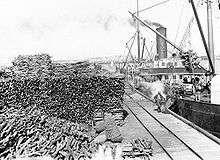Santalum spicatum
| Santalum spicatum | |
|---|---|
| Scientific classification | |
| Kingdom: | Plantae |
| (unranked): | Angiosperms |
| (unranked): | Eudicots |
| (unranked): | Core eudicots |
| Order: | Santalales |
| Family: | Santalaceae |
| Genus: | Santalum |
| Species: | S. spicatum |
| Binomial name | |
| Santalum spicatum (R.Br.) A.DC. | |
Santalum spicatum, Australian sandalwood, is a tree native to semiarid[1] areas at the edge of Southwest Australia. The Noongar peoples know the plant as uilarac, waang, wolgol or wollgat.[2] It is traded as sandalwood, and its valuable oil has been used as an aromatic, a medicine, and a food source. S. spicatum is one of four high-value Santalum species occurring in Australia.
Description
It is one of four species of the family Santalaceae to occur in Western Australia. It has a similar distribution to quandong (Santalum acuminatum) and is a hemiparasite requiring macronutrients from the roots of hosts. It has a shrubby to small tree habit, but can grow to 6 metres and is tolerant of drought and salt. The foliage is grey-green in colour. The fruit of S. spicatum is spherical, about 3 cm in diameter and is orange. An edible kernel with a hard shell forms the bulk of the fruit; the shell is smoother than S. acuminatum's deeply pitted surface. Germination occurs during warm and moist conditions. The impact of overcultivation and land clearing for agriculture, since the 1880s, has greatly reduced the range of the species.
Composition of oils
The oils produced by the tree contain a greater complexity of chemicals, many of which have antimicrobial qualities.[3]
The seed oil contains ximenynic acid[4]
Commercial use


The harvest and export of S. spicatum has been an important part of the Western Australian economy, at one time forming more than half of the state's revenue. Settlement of the Wheatbelt area was accelerated by the funds generated by sandalwood found there. Distribution and population of the endemic stands were significantly affected during periods of rural development and economic downturn.
Research by the Forestry Products Commission (Western Australia), state universities and private industry is being undertaken into the cultivation of the tree and the properties of its wood and nuts.[5][6] Replanting has occurred at some properties as a land restoration strategy, a food crop and in the long term for harvest. Oil valued at $1 000(AUD) per kilogram is produced at Mount Romance in Albany, Western Australia.[7] The area of commercial plantations has risen from seven to 70 km² between 2000 and 2006. The export of 2 000 tonnes of sandalwood a year is primarily sourced from wild stands of the remote rangelands and Goldfields Region of Western Australia. The harvest of naturally occurring trees is reduced when compared to the industry of the 19th century. Exports of over 50 000 tonnes in the last decade were related to agricultural expansion by increased access and harvesters.[8]
Cultivation
Germination is difficult, and may depend on the El Niño cycle. Success has been reported by placing the kernels in moist vermiculite in sealed plastic bags at room temperature. Once germinated, seeds should be planted next to a (preferably Australian native) seedling, and watered adequately.
Host species
The main host species is Acacia acuminata, which is used in plantations, which sustains a 15- to 30-year long-term host species in loamy sands over clay duplex soils. Rock sheaok Allocasuarina huegeliana, wodjil Acacia resinimarginea and mulga Acacia aneura are also used.[9]
References
- ↑ Sandalwood(Santalum Spicatum) Guide for Farmers - Tree Facts pamphlet- Forest Products Commission - April 2007 specifically states Wheatbelt and areas with minimum 400 mm annual rainfall
- ↑ "Noongar names for plants". kippleonline.net. Retrieved 15 December 2016.
- ↑ "Santalum". Florabase. Department of Environment and conservation. August 2002. Retrieved 2007-04-29.
/browse/flora?f=092&level=g&id=523 et al.
- ↑ Separation and identification of ximenynic acid isomers in the seed oil of Santalum spicatum R.Br. as their 4,4-dimethyloxazoline derivatives. Yandi et al. 1996
- ↑ University of Queensland site's detail
- ↑ Australian Arid Lands Botanic Garden - Plants: Sandalwood, Santalum spicatum
- ↑ Murphy, Sean (reporter) (2007-04-27). "High hopes for native sandalwood". Landline (transcript). ABC. Retrieved 2007-05-01.
Most of WA's native sandalwood harvest ends up at the Mt Romance essential oil factory in Albany, on the south coast of WA. It is converted into a liquid fetching as much as $1,000 a kilogram.
- ↑ WA Gov site's detail
- ↑ Sandalwood Guide for Farmers states "being a root hemi-parasitic tree.. it is planted with a nitrogen-fixing host species such as jam Acacia acuminata"